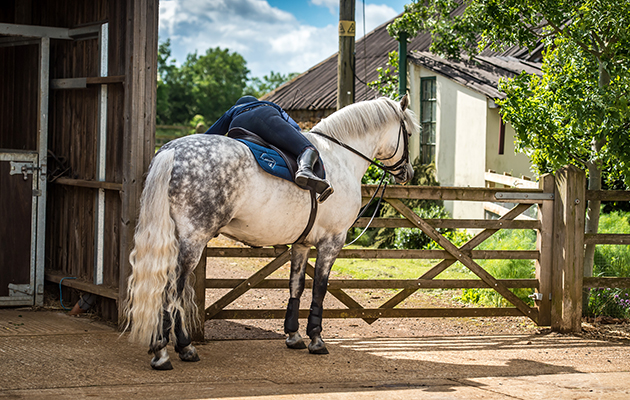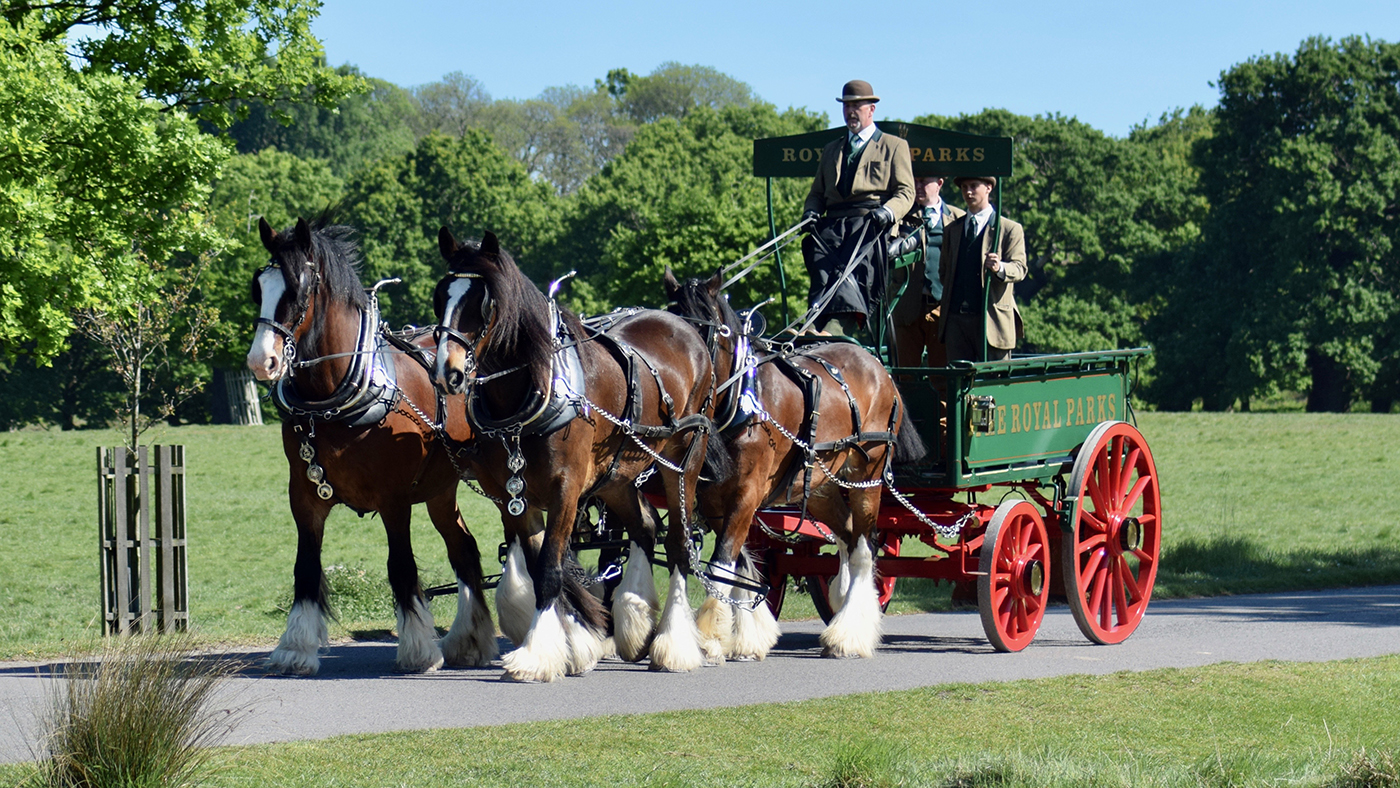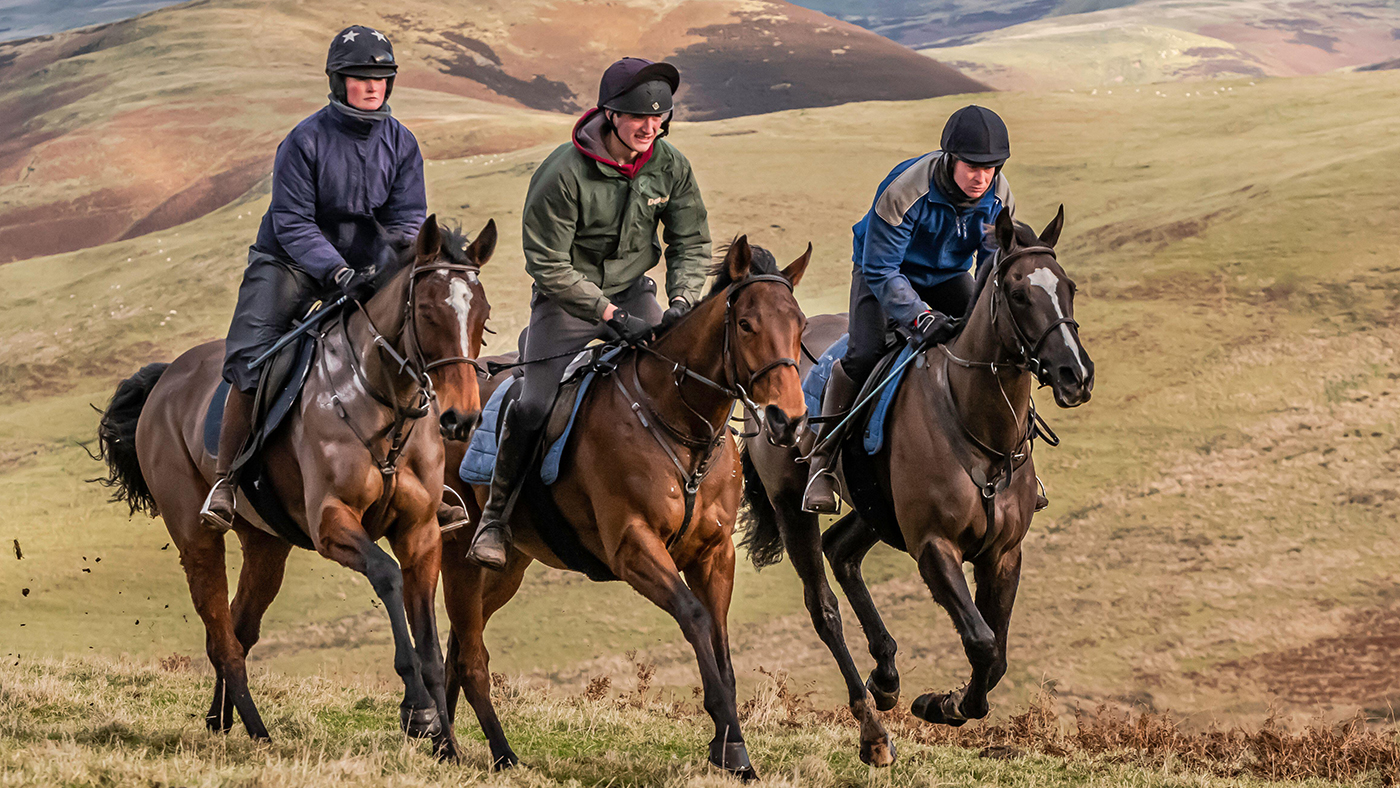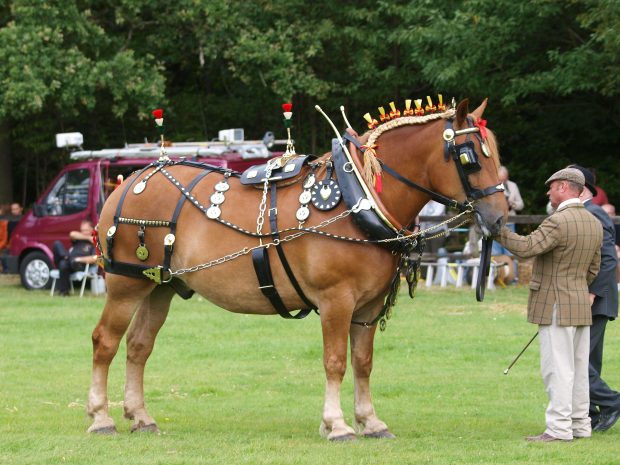There are a wide variety of UK horse breeds, ranging from the diminutive hardy Shetland pony that still roams freely across the Shetland Isles off the north east coast of mainland Scotland, through to the majestic Shire horse that is believed to have originated in the east midlands of England and stands over 17hh.
From the speed and intelligence of the athletic British thoroughbred to the versatility of Britain’s popular native ride-and-drive ponies, whatever type of equestrian activity you are looking to follow, there will be a breed of horse with its origins in the UK that can cater for your needs.
British native ponies
There are 12 different breeds of British native ponies that are allowed to compete in Mountain & Moorland (M&M) showing classes, which are typically held under British Show Pony Society and National Pony Society rules. These classes can be split by breed, by height (typically for working hunter pony classes) or combined into small breed (Shetland, Exmoor, Dartmoor, Welsh A and Welsh B) and large breed (Welsh D, Welsh C, New Forest, Connemara, Dales, Fells, Highland) classes.
Shetland pony

A champion Shetland at the Royal Highland Show
Starting at the most northern point of the British Isles, The Shetland pony is the smallest of the UK’s native ponies, standing between 28 and 42 inches high at the wither. The breed developed on the Shetland Isles with little influence from more modern breeds, and the ponies are notable for their hardiness and longevity. Their size and strength meant they were in demand as pit ponies when they arrived in mainland Britain during the mid-19th century. Now they are popular mounts for small children, make good driving ponies, are used as therapy ponies and are popular as companions for larger equines. The ponies can be good jumpers and can be seen at county shows around Britain taking part in the popular Shetland Pony Grand National series.
Highland pony

Also originating from Scotland, the Highland Pony is one of the largest of the British native breeds. It is a strong, well-balanced, compact pony that should show substance and strength. The breed is a popular family pony for riding and driving and is also used as a pack animal, being used to transporting deer and other game off the Scottish hills. Many Highlands are capable jumpers and can also perform well during long distance rides. The breed is a favourite of The Queen, who has a large working stud of Highland ponies at Balmoral.
Dales pony

The Dales pony is native to the upper dales of the eastern slopes of the Pennine range, from the High Peak in Derbyshire to the Cheviot Hills near the Scottish Border. It is typically between 14hh and 14.2hh with only black, brown, grey, bay or roan coats (and only limited white markings) allowed. Dales ponies are popular for both riding and driving, where their impressive and stylish trot also makes them much sought-after, as well as being a solid choice for a working hunter or an all-round mount due to their intelligent, kind natures and versatility.
Fell pony

A Fell pony living on the hills in its native Lake District in Cumbria.
The Fell pony breed is native to the north west of England, and are mostly found in Cumbria where herds of registered ponies still live on the Cumbrian fells. The Fell is an ideal all-round family pony for adults and children as well as a popular choice in the show ring. They cannot exceed 14hh in height and while there is no lower height limit, there are very few under 12.2hh. Historically Fells were used for pack work carrying loads of fleeces, woollen goods, foodstuff and local metal ores. They were also used for shepherding and to hunt wolves. Known locally as ‘galloways’ , Fell ponies were also used for the Cumberland sport of trotting races as well as by big Northeastern collieries.
New Forest pony

Semi-feral New Forest ponies are often seen grazing alongside the roads in the region.
The New Forest pony is native to central southern England. Official records of horses in the New Forest date back to 1016 when rights of common pasture were granted to the people living in what was then a royal hunting ground. New Forest ponies measure up to 148cm and excel across the equestrian disciplines. They are popular choices for pony club and riding club all-rounders as well showing, hunting, jumping and dressage ponies. They are quite capable of carrying adults, while narrow enough for small children.
Dartmoor pony

Heading to the south west, the Dartmoor pony is the British native breed of the English county of Devon. The ponies have been recorded living on the moors of Dartmoor since the middle ages, meaning they have developed to be hardy and resilient. They cannot exceed 12.2hh and should be sturdily built yet with quality, like a scaled down middleweight hunter, making them a very good riding pony. Dartmoor ponies were originally used to carry tin from the mines, for farm work and as pack-horses for transporting goods. Today, the breed is seen as an excellent all-round child’s pony, although they are also ridden by small adults.
Exmoor pony

The Exmoor pony is one of the UK’s oldest native horse breeds. They also originate from the south west of England and the first written record of ponies on Exmoor, when it was a designated Royal Forest, can be found in The Doomsday Book. Historically, the ponies were used by hill farmers to undertake all kinds of work from being ridden for shepherding to in harness for ploughing, harrowing, taking feed to stock and the farmer’s family to market and church. Nowadays Exmoors’ versatility sees them being used as all-round mounts for smaller adults and children alike. They have also proven to be excellent conservation grazers and being used for this purposes at a number of locations both in the UK and around the world.
Welsh cob (section D)

Adam Forster and Menai Eurostar won the M&M Welsh section D class at HOYS 2021.
Moving west into Wales, the largest of the four Welsh native pony breeds, the Welsh section D — or the Welsh Cob — has no upper height limit, but must exceed 13.2hh, while retaining its pony character and true Welsh type. Described by the Welsh Pony & Cob Society as “the best ride and drive animal in the world”, the Welsh Cob is a popular choice for adults, both under saddle and in harness. They can make a good hunter and perform well across all the ridden disciplines as well as being popular in the show ring for both ridden and driven classes, as well are competing successfully in combined driving trials.
Welsh pony of cob type (section C)

The Welsh section C – Welsh pony of cob type – should not exceed 13.2hh (137.2cm) and is a hugely popular British pony breed for both adults and children alike. The Welsh C is an athletic, compact and sturdy pony, with more body and bone than the Welsh pony (section B). It’s power, strength and depth of girth makes them popular all-rounders and a common sight in the show ring. They are also found competing across the performance disciplines as they can excel on the jumping circuit or be successful dressage ponies. The section C is one of the most versatile native breeds, being suitable for riders across a range of ages.
Welsh pony (section B)

The Welsh section B or Welsh pony cannot exceed 13.2hh (137.2cm) and is a taller and more refined version of the Welsh Mountain Pony (section A). Welsh section Bs are arguably the most versatile and successful of the Welsh breed across the disciplines due to their athleticism, which enables them to compete successfully against quicker and finer non-native breeds. Many modern section Bs are also successful in plaited showing classes, standing at the top of show hunter pony lines ups at championship level, while their straighter, lower and longer-striding movement makes them very suitable as ridden ponies. They typically jump well and can be great all-rounders for children.
Welsh mountain pony (section A)

The Welsh section A or Welsh Mountain Pony is the smallest of the four Welsh breeds standing no taller than 12h (121.9cm). The Welsh section A is a popular choice for children, with many being seen in lead rein and first ridden classes in the show ring. It is believed the Welsh Mountain Pony has existed since prehistoric times, being used by farmers as ridden animals as well as in the pits and mines after the industrial revolution. Welsh As typically have a good jump and easy temperaments, making them ideal first ponies for children that can turn their hooves to most disciplines at starter level and make good all-round Pony Club ponies.
Connemara pony

Heading further west across the Irish Sea, The Connemara pony originates from County Galway on Ireland’s west coast, a wild area of peatbogs, lakes, mountains, and rugged coastline. It could be argued that as this region is not part of the United Kingdom, the Connemara should not be included in a guide to UK horse breeds, but as it is one of the official large breed M&Ms that are often seen in the British show ring, it would be remiss of us not to include it here. Connemara ponies are incredibly popular around the world thanks to their excellent temperament and versatility, combined with their athletic build, making them a fun pony for both children and adults alike. While the official upper height limit for the breed is 15hh, the ponies make popular part-breds with thoroughbreds and Irish Draughts, as well as there being an increasing market for over-height purebred ponies as they make great competitive all-rounders for amateur riders of all ages.
Other ponies that are UK horse breeds, but which are not allowed to compete in M&M classes, include the rare Eriskay pony and the Dartmoor Hill Pony, which covers ponies living in that region that do not have full Dartmoor Pony Society-registered bloodlines.
UK horse breeds: heavy or draught horses
Back in the days when traditional horse power ruled the world, Britain’s draught or heavy horse breeds, including the Shire, Clydesdale and Suffolk horse, were pivotal in heavy work on the land to ensure food production was maintained as well as moving both people and goods around the country via barge, wagon and carriage. They were prized for their ability to pull heavy loads, with the majority of their work being in harness rather than under saddle.
The Shire horse

The Shire horse is a British draught horse, thought to have originated in Lincolnshire and Cambridgeshire, that is believed to have descended from “the Great Horse,” a popular war mount from the Middle Ages. Shires are renowed for their size – they are usually around 17hh to 17.3hh – and strength — a pair of Shires in the 1920s allegedly pulled a load weighing more than 45 tons. These are majestic horses, with a high, arched neck, well sprung ribs, powerful, sloping hindquarters, and heavy feathering on the legs. They are typically gentle giants, calm and friendly with an even temperament. Some breweries still use teams of Shire to pull drays, for local deliveries and for promotional purposes. A small number of small farms utilise Shires and other heavy horses instead of tractors, to be more environmentally sustainable. Shires are also still used in logging, and some land management, as they can access areas that a vehicle can’t get to and typically inflict less damage to the ground.
The Clydesdale

The Clydesdale horse is native to Scotland, although it is renowned the world over, thanks to its fame in the Budweiser commercials. The breed takes its name from the area around the River Clyde in Lanarkshire. This British breed of heavy horse vies with the Shire horse and the Belgian Draft for the title of the “world’s biggest horse”. Although they are tall (typically at least 17hh), they are lighter than these other draught horses due to their slighter frame, which gives the breed a certain elegance. The Clydesdale was renowned as one of the best agricultural and haulage animals of the 18th century, whereas now they are mainly used for breeding, showing, carriage driving and parades. As well as being found in showing and eco-friendly agriculture, some Clydesdales compete in general riding club activities – they give a comfortable ride being quite narrow for a heavy draft breed – and typically have an easy-going and willing temperament. They have also proved popular with the Household Cavalry as drum horses.
The Suffolk horse

The Suffolk horse – also know as the Suffolk Punch – has a history dating back to the 16th century and originated in the eastern English counties of Suffolk and Norfolk. Originally known as the Suffolk Sorrel, the breed is the only draft horse breed developed and selected exclusively for farm work. All Suffolk horses are chesnut in colour (for this breed chesnut must be spelt with only one t) and can be traced by to the breed’s founding stallion, Crisp’s Horse of Ufford, who was foaled in 1768. Following World War Two the breed’s numbers plummeted, with only nine Suffolk horses registered in the UK in 1966. While numbers have increased, it is still considered one of the rarest horse breeds in Britain. It stands 16hh to 17hh and has much less feather than its fellow heavy horses. The breed continues to be used today in commercial forestry, and as well as under saddle.
Other UK horse breeds
English thoroughbred

No guide to UK horse breeds can be complete without reference to the incredible equine athlete that is the English thoroughbred. The breed was founded in England in the 17th and 18th centuries, when English mares were bred to three imported stallions of Barb, Turkomen, and Arab lines. The General Stud Book, the first official register of horses, was established in 1791, only listing horses that could be traced to those three stallions and to 43 “Royal mares” imported under the reign of James I. Nowadays most thoroughbreds are produced for the racing industry, although thoroughbred bloodlines can be found in a vast range of breeds, from American Quarter Horses to Morgans, Irish Draughts to European warmbloods, which have been infused with their blood to enhance refinement and athleticism. Thoroughbreds are also popular choices for polo, hunting, team chasing and eventing, among other disciplines.
The British Riding Pony

Mia Donaldson riding show pony Wilderness Early Bird.
The British Riding Pony is a combination of the best thoroughbred, Arabian and British native pony bloodlines, blended by discerning breeders since the 20th Century to produce the ultimate riding pony. Registered ponies can be either the direct progeny of a British Riding Pony sire and dam, or part-breds of British native ponies with Arabs or Thoroughbreds. These quality ponies are renowned for their beauty and elegance, with floating and ground covering movement. British Riding Ponies not only compete with tremendous success in the show ring, but they also excel in dressage, eventing, showjumping and even pony racing. Many ponies were exported in continental Europe where they became the foundation stock for the German and Dutch Riding Pony studbooks.
The Hackney

The Hackney horse has its origins in the 18th century, when the thoroughbred was crossed with the Norfolk trotter, a large-sized trotting harness horse originating in and around Norfolk in the east of England. Hackneys are best known are carriage horses, typically shown in private driving competitions, and well known for their flashy high-stepping trot. Among UK horse breeds, the Hackney is one of the most at risk. It is on the Rare Breed Survival Trust’s 2022/23 watchlist in the “priority” category after just 31 registered foals were born in 2021. In 2011 the breed had more than 300 breeding females. The Hackney Horse Society is trying to promote the breed’s versatility as good all-rounders, rather than keeping the breed solely or driving and showing.
Cleveland Bay

The Cleveland Bay originates from the Cleveland area of north east England and its history pre-dates written records. It is one of the UK horse breeds that combines substance, activity, stamina and a good temperament, which made it suitable for lighter farm work, pulling coaches, following hounds and taking families to church. Many European warmblood horses have Cleveland Bay in their ancestry, notably the Oldenburg which used Cleveland bay stallions extensively in the 1860s. The Queen’s decision to purchase a pure Cleveland Bay colt named Mulgrave Supreme and stand him at public stud in the 1960s did much to boost the breed, which went on to produce top quality horses compete in driving, dressage and showjumping at the highest level.
You may also be interested in…

Small but perfectly formed: all you need to know about the miniature horse

¡Ole! Spanish, Iberian or PRE? What makes an Andalusian horse?
Get all the facts and figures about Andalusian horses

The original Black Beauty? All you need to know about the magnificent Friesian horse

Subscribe to Horse & Hound magazine today – and enjoy unlimited website access all year round
Horse & Hound magazine, out every Thursday, is packed with all the latest news and reports, as well as interviews, specials, nostalgia, vet and training advice. Find how you can enjoy the magazine delivered to your door every week, plus options to upgrade your subscription to access our online service that brings you breaking news and reports as well as other benefits.




